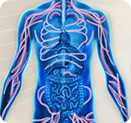What is Lymphoma? |
|
 |
Lymph is considered a part of the interstitial fluid, the fluid which lies in the interstices of all body tissues. Interstitial fluid becomes lymph when it enters a lymph capillary. The lymph then travels to at least one lymph node before emptying ultimately into the right or the left subclavian vein, where it mixes back with blood. Lymph returns protein and excess interstitial fluid to the circulation. Lymph picks up bacteria and brings them to lymph nodes to be destroyed. Metastatic cancer cells can also be transported via lymph. Lymph also transports fats from the digestive system. Typically, lymphomas appear as a solid tumor of lymphoid cells. These malignant cells often originate in lymph nodes, appearing as an enlargement of the node (a tumor). It can also affect other organs in which case it is referred to as extranodal lymphoma. Extranodal sites include the skin, brain, bowels and bone. |
|
There are two major types of lymphoma: Hodgkin's disease and non-Hodgkin lymphoma (NHL). Understanding Risk Factors for LymphomaEpstein-Barr virus (EBV) DNA has been identified in tumor tissue from many of patients, indicating an important and early role for the virus in tumor development. The cause of Hodgkin’s disease remains unknown. Symptoms of LymphomaNon-specific symptoms could be anorexia, dyspnea (shortness of breath), fatigue, fever of unknown origin, lymphadenopathy, night sweats, pruritus, and weight loss. Diagnosis of LymphomaA blood test will determine a diagnosis of lymphoma. Treatment Options for Lymphoma at Premier Cancer Center: |
|
|
Most Common Side Effects of Radiation Therapy for Lymphoma• Side effects are generally related to the treatment area itself |
|





